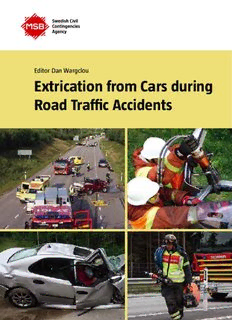
Extrication from cars during road traffic accidents PDF
Preview Extrication from cars during road traffic accidents
Editor Dan Wargclou Extrication from Cars during Road Traffic Accidents Editor Dan Wargclou Extrication from Cars during Road Traffic Accidents Swedish Civil Contingencies Agency (MSB) Extrication from Cars during Road Traffic Accidents Editor: Dan Wargclou Project manager: Ingvar Hansson English version: James Butler Layout: Advant Produktionsbyrå AB Published: 2011 Publication number MSB317 - October 2011 ISBN: 978-91-7383-165-9 2 Content Introduction 9 ....................................................................... Time is precious! ...................................................................... 9 Book layout.............................................................................11 1. Safety systems 13 .............................................................. Euro NCAP.............................................................................16 Frontal impact ........................................................................17 Side impact...........................................................................17 Pole test..............................................................................18 Colliding with a pedestrian............................................................18 Child safety...........................................................................19 Whiplash.............................................................................19 Batteries...............................................................................20 Cutting power........................................................................21 Automatic battery disconnection......................................................21 Belt pretensioners....................................................................22 Airbags.................................................................................22 How an airbag works................................................................ 23 Fire......................................................................................24 Volvo S80 airbag system............................................................24 Identifying a vehicle with an airbag..............................................25 Medical effects of airbags..........................................................27 Airbags and the fire brigade.......................................................28 Frequently asked questions and answers about airbags .........................30 Other safety systems.................................................................32 Whiplash protection..................................................................32 Roll-over protection systems...........................................................33 Safety glass...........................................................................33 Protective systems ...................................................................33 WHIPS (Whiplash Protection System).................................................33 Seatbelts with pre-tensioners and load limiters....................................... 34 Side body-airbags.................................................................... 34 IC (Inflatable Curtain)................................................................ 34 Low front cross-member............................................................. 34 Pedestrian protection ................................................................ 34 Two stage airbags.....................................................................35 Pre-prepared restraints................................................................35 Preventive systems...................................................................35 DAC (Driver Alert Control).............................................................35 3 LDW (Lane Departure Warning).......................................................35 ACC (Adaptive Cruise Control)........................................................ 36 Collision warning with autobraking................................................... 36 RSC (Roll Stability Control)........................................................... 36 Volvo On Call.........................................................................37 DSTC (Dynamic Stability and Traction Control).........................................37 BLIS (Blind Spot Information System).................................................37 Rear view camera.....................................................................37 2. Different fuels 39 .............................................................. Electric and hybrid cars .............................................................39 Voltage and high energy content.....................................................40 Battery technologies................................................................. 43 Chemical risks in connection with the handling of batteries in electric and hybrid vehicles .....................................................................45 Identification........................................................................ 46 Fire in a battery pack..................................................................47 Recommendations during an emergency response...........................48 Collisions............................................................................ 48 Fire extinguishing ................................................................... 48 Gas vehicles...........................................................................49 Vehicle gas (methane)............................................................... 49 Engine gas (LPG)..................................................................... 50 DME................................................................................. 50 Hydrogen............................................................................ 50 Gas systems in methane-powered vehicles............................................51 Safety equipment.....................................................................51 Gas systems in LPG-powered vehicles..................................................53 Is the vehicle gas-powered?...........................................................53 Recommendations during an emergency response...........................54 Collisions............................................................................ 54 Fire.................................................................................. 55 E85......................................................................................56 Risks during fire-extinguishing....................................................... 56 How much more akward is it to extinguish fires involving E85?........................57 3. Road environment 61 ...................................................... 2+1 roads.............................................................................. 61 Dividing the carriageway with a wire-rope barrier............................. 61 Dismantling wire-rope barriers....................................................63 Accident on 2+1 road ...............................................................64 Cutting of wire-rope.................................................................65 Barriers.................................................................................65 4 4. Equipment 69 ................................................................... Portable hydraulic pumps..........................................................72 Hydraulic hoses and hydraulic couplings........................................73 Design of cutters.....................................................................75 Personal protective equipment (PPE)............................................76 Crash Recovery System..............................................................78 5. Organisation on scene 81 ................................................ Making the accident site safe......................................................81 Cordoning off a road.................................................................82 Some simple advice that should be taken into account follows, however:.82 The Falköping model................................................................83 The most important features of the method are presented below, with brief suggestions:............................................................... 83 Equipment in position:............................................................... 86 Examples from the handbook of cordoning off roads using the Falköping model.......87 Accident site...........................................................................90 Positioning of vehicles................................................................91 Standard routines.................................................................... 92 The incident commander’s tasks..................................................... 92 Traffic control officer/medic/extricator............................................... 92 The safety officer..................................................................... 93 Medic/extricator..................................................................... 93 Driver/tool officer.................................................................... 94 Medical services organisation.....................................................96 The police..............................................................................98 Traffic information, traffic control and handling of disruption...............99 6. Extrication 101 .................................................................. Read the accident!..................................................................101 Documentation..................................................................... 104 Assessing the condition of casualties........................................... 104 Critically injured..................................................................... 104 Examination and measures according to L-ABCDE ....................................................105 Choice of extrication method.................................................... 106 Non-deployed airbag............................................................... 108 Action plan for dealing with an RTA (road traffic accident)........................... 109 Criteria for how to assess the condition of a casualty..................................110 Extrication methods.................................................................111 5 A. Uninjured or slightly injured, no signs of back or neck injury.............111 B. Suspected back or neck injury, other signs good, casualty not trapped.................................................................111 Action plan for attending to casualties................................................112 1. Stabilise the vehicle................................................................112 2. Disconnect the power supply......................................................112 3. Attend to the casualty.............................................................113 4. Remove side and rear windows....................................................114 5. Cut off the seatbelt................................................................115 6. Cut the pillars.....................................................................115 7. Saw the windscreen...............................................................117 8. Lift off the roof....................................................................118 9. Cover sharp edges with edge protectors...........................................118 10. Lift the casualty out ...................................119 C. Suspected back or neck injury, casualty trapped...........................120 D. Critically injured, casualty not trapped.......................................121 Action plan for rapid extrication......................................................121 E. Critically injured, casualty trapped............................................123 The cylinder technique...............................................................123 The pulling method..................................................................127 Dash lift.............................................................................135 Car on its side........................................................................138 1. Attend to the casualty............................................................. 138 2. Stabilise the vehicle.............................................................. 138 3. Take care of the casualty.......................................................... 138 4. Disconnect the battery............................................................ 140 5. Remove side windows and rear window.......................................... 140 6. Cut the pillars.....................................................................141 7. Saw the windscreen...............................................................142 8. Make notches in the edge of the roof to weaken it.................................142 9. Bend the roof down...............................................................143 10. Cut away the steering-wheel rim..................................................143 11. Lift the casualty out.............................................................. 144 Car on its roof........................................................................145 1. Attend to the casualty..............................................................145 2. Stabilise the vehicle...............................................................145 3. Disconnect the battery............................................................ 146 4. Remove the side windows and rear window...................................... 146 5. Prise the door away.............................................................. 146 6. Lift out........................................................................... 146 Alternative A: Open the car from the side............................................ 148 7A. Create space.................................................................... 148 8A. Cut the pillars................................................................... 148 9A. Widen the opening between the roof and floor.................................. 148 10A. Lift the casualty out............................................................ 148 Alternative B: Open the car from the rear............................................ 149 7B. Create space.................................................................... 149 6 8B. Cut the pillars................................................................... 149 9B. Widen the opening between the roof and floor.................................. 149 10B. Lift the casualty out............................................................ 149 F. Fatality..............................................................................151 7. Post-emergency work 153 ................................................ What can we throw back into the vehicle?............................................154 What must we not throw back into the vehicle?......................................154 Follow-up and evaluation..........................................................155 Evaluation...........................................................................155 In-depth studies......................................................................156 Further reading .................................................................... 160 Photo credits........................................................................ 160 Footnotes.............................................................................162 7 Introduction Every.year.around.70,000.road.traffic.accidents.occur.in.Sweden.. According.to.the.2009.statistics.from.Transport.Analysis1.397.pe- ople.were.killed.on.the.roads.in.20082..26,248.people.were.inju- red,.of.which.3,657.seriously3.... A.road.traffic.accident.in.which.one.or.more.seriously.inju- red.people.are.trapped.is.a.demanding.situation.from.both.the. technical.and.medical.points.of.view..The.condition.of.casualties. must.not.be.made.worse.by.the.extrication.operation,.and.medi- cal.treatment.must.not.be.delayed. .Research.suggests.that.damage.to.the.cervical.spine.occurs.in. most.types.of.accident..According.to.the.survey,.conducted.by. the.insurance.company.Folksam,.How.Safe.are.Cars.2009.on.se- rious.injuries.that.have.resulted.in.10%.or.more.incapacity,.neck. injuries.have.shown.the.greatest.increase..In.the.mid-seventies. Time is precious! 30%.of.these.injuries.involved.the.neck..During.the.nineties.this. proportion.rose.to.60%. .It.must.be.possible.to.lift.a.casualty.out.of.the.vehicle.without. his/her.neck.and.back.being.twisted..We.know.that.twisting.or. incorrect.lifting.can.incapacitate.the.casualty.for.life..This.means. that.it.may.be.necessary.to.lift.off.the.roof.of.the.car,.even.if.the. casualties.are.not.trapped.. It.is.important.that.we.can.attend.to.people.involved.in.road. traffic.accidents.quickly.and.in.the.best.way.possible..The.Swe- dish.Civil.Contingencies.Agency.has.therefore.produced.routines. for.each.person.in.the.crew,.zones.around.the.accident.site.and. an.action.plan.for.extrication.that.follows.the.action.plan.for. medical.assistance. Time is precious! The.main.message.is.that.time.is.precious..There.is.a.need.to.coor- dinate.the.work.of.medical.personnel.and.fire.brigade.personnel. and.to.make.use.of.natural.breaks.in.one.another’s.activities..It. is.important.that.the.fire.brigade,.emergency.medical.services. and.police.interact.well.to.ensure.a.good.outcome..The.aim.is. to.shorten.the.extrication.time.and.improve.care.of.the.casualty. so.that.he.or.she.is.in.a.better.or.no.worse.condition.after.being. extricated.than.when.the.units.arrived.on.the.scene..The.concept. of.the.extrication.time.means.that.a.casualty.is.to.receive.hospital. treatment.within.one.hour.of.the.accident.happening...The.extri- cation.work.should.be.carried.out.after.the.medical.care.work.. All.parties.involved.have.to.work.as.a.team,.in.which.everyone. 9
Description: